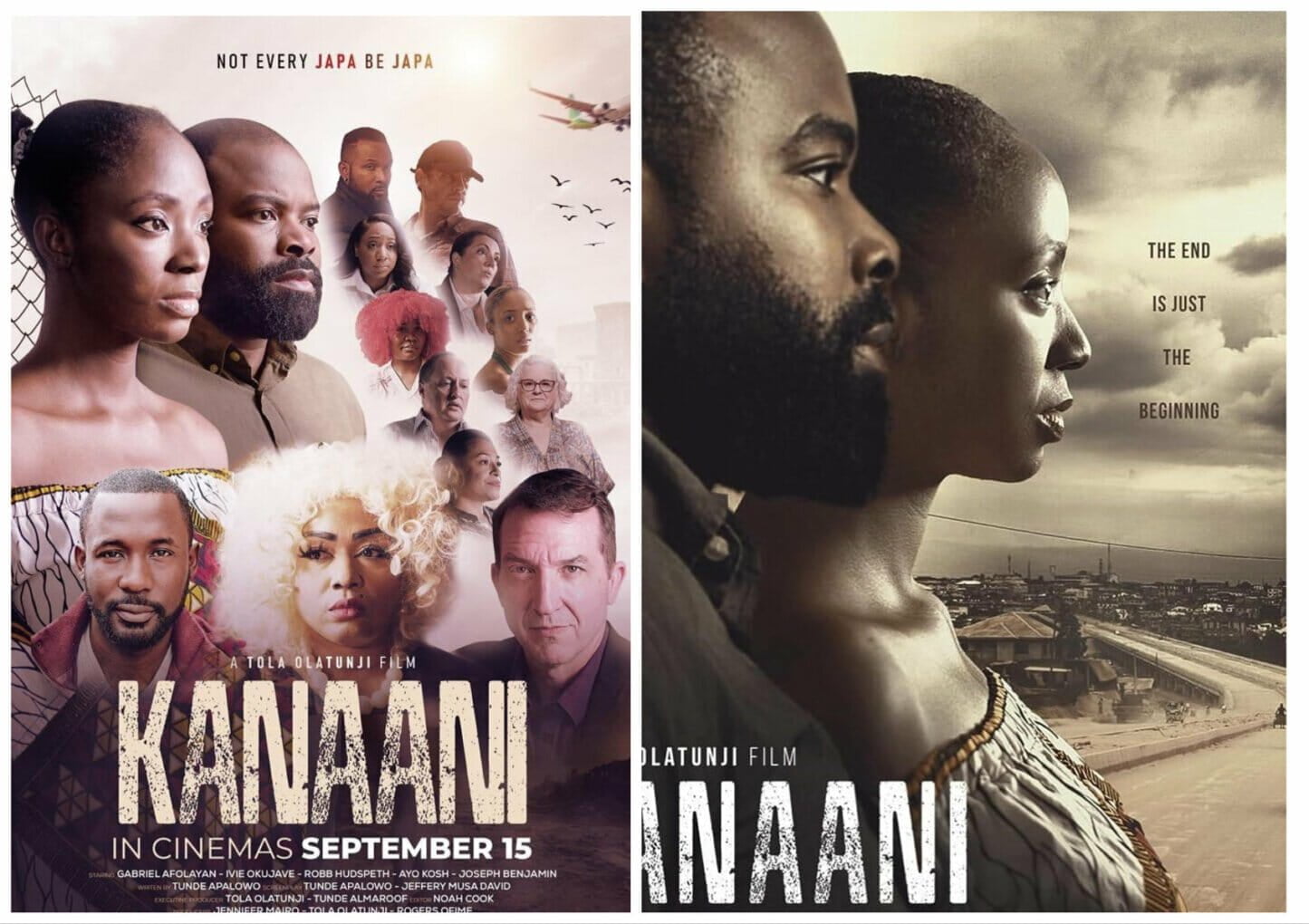Movie Review: “Kanaani” is a must-see masterpiece that addresses the Japa Syndrome

The highly anticipated collaborative effort of Tola Olatunji and Jennifer Mairo, “Kanaani,” brought to the screen in partnership with FilmOne, has emerged as a cinematic masterpiece that effortlessly bridges Nollywood and Hollywood.
The film, which dropped in cinemas today, undeniably lives up to its lofty expectations, delivering a compelling narrative that is both emotionally charged and socially relevant.

Stellar Cast Ensemble
Produced by Jennifer Mairo and penned by the talented team of writers, including Babatunde Apalowo, Musa Jeffery David, and Tola Olatunji, “Kanaani” boasts a stellar ensemble cast that seamlessly blends seasoned Nollywood and Hollywood talents. With names like Gabriel Afolayan, Ivie Okujaye, Rob Hudspeth, Ayo Kush, Joseph Benjamin, Robert Emuas, David OZ Maya, and Heyoka Rivas among others, the film sets a high bar for performance.
What is “Kanaani” About?
Set against the captivating backdrop of a picturesque fishing village in Edo state, “Kanaani” unfolds the poignant love story of Obehi and Gbovo, portrayed with remarkable chemistry by Gabriel Afolayan and Ivie Okujaye. Their enduring love faces the ultimate test as they navigate unforeseen twists and adversities, leading them into the harrowing world of human trafficking and illegal migration.
In the movie, Obehi receives her visa to America while Gbovo’s does not, prompting a heart-wrenching decision for them both as they initially planned to go together. What follows is a riveting tale of separation, suffering, and the quest for reunion. Did Obehi get to America which was her initial destination? Did Gbovo go after her? What happened to the lovebirds? Your answer awaits you in the cinema.
Outstanding Character Portrayal
The standout feature of “Kanaani” lies in its character portrayals. Particularly commendable are the performances of the lead characters, Gbovo and Obehi, who convey every emotion with vivid authenticity. The film takes its audience on an emotional rollercoaster, allowing viewers to truly experience the pain, joy, suffering, and resilience of the characters. Even the antagonist characters excel in their roles, immersing the audience in their malevolent personas.
Use of Language and Props
The use of languages, including Bini, pidgin, and English, adds depth and context to the film’s geographical setting and character backgrounds. It cleverly distinguishes the characters from rural and urban backgrounds, enhancing the film’s authenticity. The attention to detail in costumes and props further enriches the storytelling, with scenes such as the police search leaving a lasting impact.
Thematic Preoccupation of “Kanaani”
“Kanaani” fearlessly tackles the pressing issue of human trafficking, shedding light on the horrifying process of forced capture and the inhumane conditions endured by trafficked victims. It also explores the profound effects of these ordeals on the loved ones left behind, exemplified through Gbovo’s financial struggles caused by his commitment to Obehi’s journey and the death of Obehi’s mum. The film captures the anguish and sacrifices experienced made by families.
Furthermore, “Kanaani” delves into the dark realities of illegal migration, exposing the brutal treatment faced by those who attempt the perilous journey to America. The film does not shy away from the pain and grotesque experiences associated with this perilous journey as shown in the ordeals of Gbovo.
Amidst the grim depiction of human trafficking and its consequences, “Kanaani” also highlights the resilient spirits of its main characters. Obehi’s unwavering determination and Gbovo’s unyielding resolve in the face of adversity serve as powerful sources of inspiration. Obehi’s declaration, “You can never break my spirit,” encapsulates the indomitable human will.
Cinematography in the Movie
The film’s portrayal of Edo state is visually stunning, capturing the essence of its landscapes, the serenity of the fishing river, and the authenticity of its rural settings.
The cinematography in “Kanaani” excels in its ability to convey the story visually. The skilled use of lighting is evident throughout the film. It is not merely a technical aspect but a powerful storytelling tool. The cinematographers adeptly manipulate light to create mood and atmosphere, whether it’s the warm, intimate glow during moments of love and hope or the stark, harsh lighting in scenes of despair and hardship. This dynamic interplay of light and shadow enhances the emotional impact of each moment.
The composition of shots in “Kanaani” is meticulous and purposeful. Every frame is carefully framed to draw the viewer’s attention to the most critical elements of the scene. Whether it’s a close-up capturing the raw emotion on a character’s face or a wide shot showcasing the vastness of the landscape, each composition contributes to the overall storytelling.
The cinematography employs a variety of camera movements to enhance the storytelling. It seamlessly transitions between steady, static shots that allow viewers to absorb the details and emotional nuances of a scene and dynamic camera movements that inject energy into moments of tension and conflict. The fluidity of these camera movements adds depth to the narrative and keeps the audience engaged.
One of the standout aspects of the cinematography is its commitment to authenticity. The film’s depiction of Edo state, its landscapes, and the everyday life of its people is visually striking and true to the region’s cultural and geographical context. The use of practical locations and settings enhances the film’s credibility.
Through its powerful themes, compelling storyline, and stellar performances, “Kanaani” emerges as a must-see film. It offers profound insights into the negative consequences associated with the contemporary “japa” movement—a movement that often conceals hidden problems.
Conclusively I must say that”Kanaani” deserves a solid rating of 8/10. It is not only entertaining but also educating and thought provoking, making it a significant addition to contemporary cinema. This cinematic gem successfully weaves a narrative that transcends borders, leaving a lasting impact on its viewers with the message “Indeed not every japa be japa”






